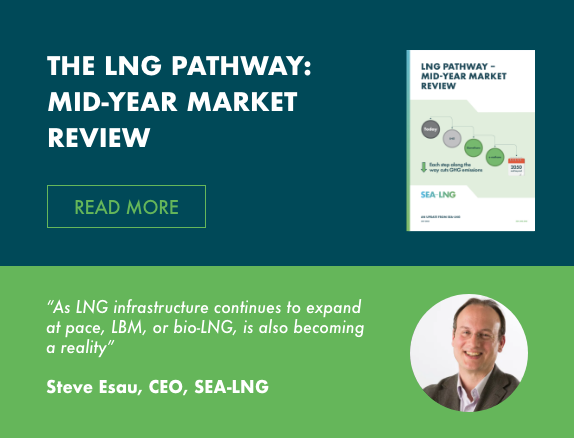3rd December 2024
Transport & Environment’s briefing should consider industry progress in addressing upstream emissions

Summary
The briefing from T&E makes claims based on a report which uses old greenhouse gas emissions estimates from a range of peer reviewed and non-peer reviewed studies and an unclear methodology. It does not consider the significant progress made by industry, for example the 45% reduction in upstream (Well-to-Tank) methane emissions achieved by members of the Oil and Gas Climate Initiative since 2017. However, it is good to note that T&E supports SEA-LNG’s long-standing position on the need for regulation of greenhouse gas emissions from shipping to be based on a full lifecycle, Well-to-Wake basis.
Full response
It is encouraging to see that Transport & Environment’s (T&E) recent briefing on LNG emissions from shipping recognises the potential of LNG as a marine fuel and makes some useful policy recommendations. However, the briefing and associated report on the Well-to-Tank Carbon Intensity of European LNG Imports are based on old data and do not consider well-advanced industry initiatives and progress in the reduction of upstream methane emissions.
The T&E briefing claims that the average upstream, or Well-to-Tank (WtT), emissions of LNG imports to Europe is some 30% higher than that assumed by FuelEU Martime mainly because of methane leaks in the LNG supply chain. The analysis it cites to support this position is provided by a report[1] commissioned from consultants Energy and Environmental Research Associates.
This report uses emissions estimates from a variety of peer reviewed, and non-peer reviewed ie government, gray, industry, and NGO studies with peer reviewed emissions estimates accounting for only 22% of the data analysed. The average year of the emissions estimates used is 2019, meaning approximately 50% of the emissions data used in the report is at least half a decade old. Additionally, there is a lack of consistency of scope between the studies analysed, the measurement techniques employed, the methodologies used to derive the emissions data and the peer review process. It is unclear how the data is then used to provide the averages referred to in the report.
Besides methodological concerns, the most important point is that the report and briefing do not take account of the progress that the upstream oil and gas industry has made in reducing methane emissions through a range of voluntary initiatives such as the Oil and Gas Climate Initiative (OGCI) and the Oil and Gas Methane Partnership (OGMP) 2.0.
The OGCI member companies, which account for approximately one third of global oil and gas production, have collectively reduced their upstream methane emissions by 45% since 2017[2] to a level approaching half the current FuelEU Martime WtT default methane intensity level.
Methane certification is another voluntary initiative that is evolving rapidly as producers seek to differentiate themselves based on the methane emissions performance of their gas production. MiQ is the fastest growing methane certification organisation and since its launch two years ago, is already certifying 5% of the global gas market and 20% of US gas production. Its target is to certify all natural gas production within this decade. In September this year MiQ announced a pilot to certify a cargo of LNG being purchased by Uniper, in Europe, from EQT Corporation, a leading US gas producer.
Methane emissions are increasingly being regulated. For example, the EU Methane Regulation which came into force in 2024, imposes a range of measurement and obligations on domestic oil and gas producers and importers; and in the US the IRA Methane Penalty, which also came into force this year, puts a fee on oil and gas producer methane emissions.
In terms of policy recommendations, SEA-LNG is pleased to see that T&E is calling for the regulation of greenhouse gas emissions from shipping to be based on a full lifecycle, Well-to-Wake basis. This is consistent with SEA-LNG’s long-standing position[3].
We agree that there is a need for common standards for the operational measurements of methane emissions and lifecycle analysis of greenhouse gas emissions to be adopted by all regulators, including the EU and IMO.
Finally, we would encourage policy makers to base methane regulations on robust Monitoring, Reporting and Verification (MRV) frameworks as this will incentivise energy suppliers, equipment manufacturers and the shipping operators to continue to innovate and invest in the development and deployment of methane emission abatement solutions.
Implementation of such regulations will provide a level playing field for all alternative marine fuels, enabling the LNG pathway to deliver on maximising its GHG reduction potential. This starts with fossil LNG today, transitioning to net-zero emissions by gradually adding liquefied biomethane and liquefied e-methane to the fuel mix, using existing infrastructure and LNG dual-fuel vessels.
[1] https://www.transportenvironment.org/uploads/files/WTT_CO2e_LNG_Imports_TE.pdf
[2] https://info.ogci.com/hubfs/2024 Progress Report/241108_OGCI_ProgressReport2024_FINAL.pdf
[3] https://sea-lng.org/2023/06/sea-lng-coalition-calls-on-imo-to-regulate-all-ghg-emissions-on-a-full-lifecycle-basis/



